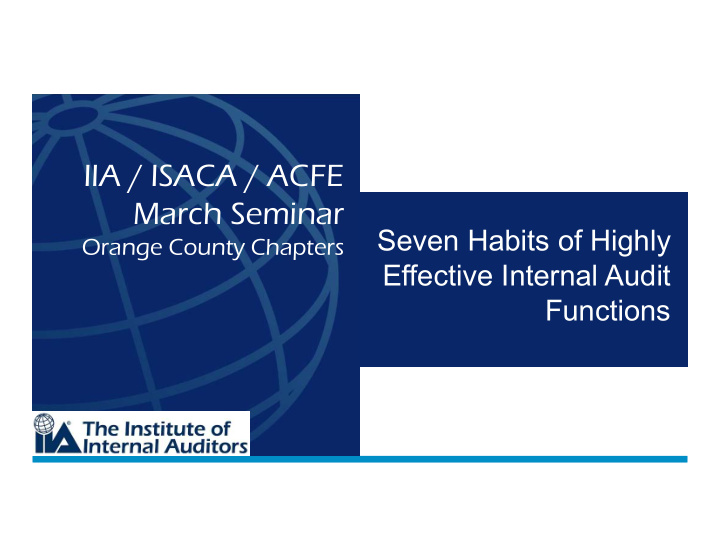



IIA / ISACA / ACFE March Seminar Seven Habits of Highly Orange County Chapters Effective Internal Audit Functions
Introduction Marina Daniel Garry Goodall EY Senior Manager EY Principal Los Angeles, CA San Francisco, CA marina.daniel@ey.com garry.goodall@ey.com Office: 1 213 977 3186 Office: 1 415 894 8454 IIA / IIA / ISACA / ISACA / ACFE Marc ACFE March Semina Seminar
Internal audit is facing pressures to evolve Major challenges facing firms will have a significant impact on internal audit Evolving regulatory agenda Changes to business model • Higher governance and control expectations in prudential • Regulatory requirements have driven down ROEs, agenda, e.g., CCAR, RRP, BCBS 239/data. necessitating business-model changes • Broadening conduct agenda, incl. strategy, product • Digital and FinTech are revolutionizing financial design, and suitability services Continually rising governance and Uncertainty culture expectations • Loss events continue to happen – process & controls • Stronger first line accountability have not really improved • Clearer roles/responsibilities across the three lines of • Demand for faster change, e.g. Agile Future of defense • Acquisitions, new entrants, obsolescence Internal • Enhanced board oversight Future of control Audit Demand on people • Common taxonomy • Ever increasing expectation of specialist knowledge • Centralized testing functions and control (product, technology, regulation, risk) – centers of rationalization excellence • Increased automation • Competition for talent (inside organization, cross industry, • Reliable metrics & KPIs service providers) Future of work Stakeholder expectations • Gen X, millennial expectations • Improve ROI on investments in controls across all LODs • Robotics, machine learning and process automation • Better leverage analytics and automation • Significant improvement in data quality and analysis • Contribute to talent development beyond IA • Provide a prospective view on emerging governance, risk and control matters. IIA / IIA / ISACA / IIA / IIA / ISACA / ISACA / ACFE Marc ISACA / ACFE Marc ACFE March Semina ACFE March Semina Seminar Seminar
Habit 1 Audit’s purpose, strategy, and objectives are universally understood, agreed and align with organizational strategies and business objectives IIA / IIA / ISACA / ISACA / ACFE Marc ACFE March Semina Seminar
Habit 2 Dynamic talent management and deployment strategies that align audit needs with auditor skills IIA / IIA / ISACA / ISACA / ACFE Marc ACFE March Semina Seminar
Habit 3 A robust risk assessment process that identifies, prioritizes, responds and adjusts to the most prevalent risks faced by your organization IIA / IIA / ISACA / ISACA / ACFE Marc ACFE March Semina Seminar
Habit 4 Audit response mechanisms that align the level of effort to the anticipated level of assurance to be provided IIA / IIA / ISACA / ISACA / ACFE Marc ACFE March Semina Seminar
Habit 5 Defined continuous monitoring routines that incorporate metrics, discussions and testing to assess impact and drive change IIA / IIA / ISACA / ISACA / ACFE Marc ACFE March Semina Seminar
Habit 6 Synthesized reporting that provides insight and perspective on governance, risk and control across the entity, lines of business and geographies IIA / IIA / ISACA / ISACA / ACFE Marc ACFE March Semina Seminar
Habit 7 Quality review programs that effectively challenge all audit processes and outcomes IIA / IIA / ISACA / ISACA / ACFE Marc ACFE March Semina Seminar
The future of internal audit • Evolving from a point control testing and independent assurance function to providing broad opinions, ongoing assurance, targeted responses and Evolution ultimately assisting the Board and Management to protect the assets, reputation and sustainability of the organization • Boards and regulators place greater reliance on Internal Audit (regulator’s portal?) to identify and escalate issues and challenge the business to prevent and resolve problems Significant drive to improve effectiveness of 1 st and 2 nd lines of defense, specifically the first line’s primary ownership for controlling various risks and • 2nd line’s effective oversight, providing significant synergistic opportunities Alignment on taxonomy, risk and control definitions, testing Agile audit approach standards & issues technology and data enabled internal audit Internal Audit Transformation Data and metrics Rise of the function Revolutionary opportunity to align the organization and apply innovative technologies to the audit process to Future Audit deliverables dramatically increase reliability and efficiency of controls Increase in reliance Greater flexibility, dynamic audit responses developed, broad and targeted opinions Internal audit remains current with business and technological change and is agile to respond IIA / IIA / ISACA / ISACA / ACFE Marc ACFE March Semina Seminar
Recommend
More recommend